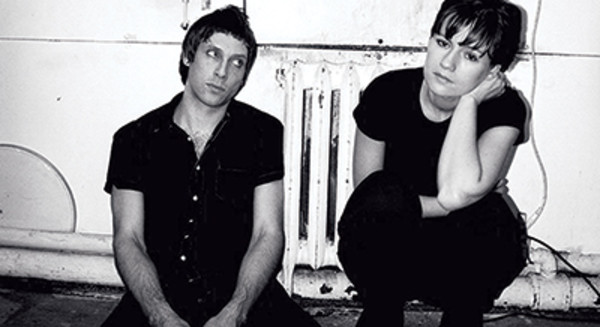Prinzhorn Dance School: DFA’s Latest
If Prinzhorn Dance School were in charge of this article, it probably wouldn’t be very […]
Prinzhorn Dance School: DFA’s Latest
If Prinzhorn Dance School were in charge of this article, it probably wouldn’t be very […]

If Prinzhorn Dance School were in charge of this article, it probably wouldn’t be very long. In fact, chances are this piece would be nothing more than a quote, a picture of the band holding some farm equipment, and a lot of white space. Not because the Brighton pair, who call themselves Suzi Horn and Tobin Prinz, have nothing to say–they just harness the power of saying very little.
Compared to mainstream pop music’s trillion-layer approach, Prinzhorn’s minimalist, self-titled debut on DFA sounds like a perverse mental experiment. Their sparse instrumentation consists of nothing more than a bass, a couple drums, and stabs of vocals and guitar, meticulously pieced together with precise gaps of nothing. Suzi Horn claims that “it’s nice to have space to drift in and find your own sounds–[like] the wobberly bit that follows the tom,” but maybe something more sinister is at work here. (The band’s name does come from Dr. Hans Prinzhorn, a German psychiatrist famous for showcasing his mentally ill patients’ artwork.)
“I like the process of thinking about sound and noise and how they fit together,” says Tobin Prinz, who carries out most of the band’s vocal duties. “I’m just trying to make visual things with an audio process, which is impossible in a way, and that’s probably why I like it–it’s an unattainable thing that I can obsess about.”
Horn, the band’s bassist, shares Prinz’s controlled enthusiasm. “We make charts to see how the songs work and how we can make them better. We probably worked for two days tuning the kick before we even mic’d it, then a day moving the mic!”
No wonder Prinzhorn ended up working with DFA’s similarly obsessive James Murphy. After the duo recorded most of their album in an isolated barn in Sussex, they sent a demo to the label stapled together with carpet underlay. Soon after, they found themselves in New York, mixing at Murphy’s Plantain Recording House. “I have a lot of respect for James [and] the way he worked on the record,” says Prinz. “It was always going to be hard because we work in isolation. And it was difficult at first, but soon the mixes began to work. I’m so happy with how the record sounds.”
As to be expected, Prinz and Horn didn’t answer questions about their favorite bands, their love life, or what cereal they ate that morning. “There isn’t much more to know, and even if there was, not knowing is the best bit,” claims Prinz. “We go into an old building and make noise late into the night. [We] scream and fight and drink vodka and send the masters to DFA and they put them out as records. That’s what we do.”

